Related Research Articles
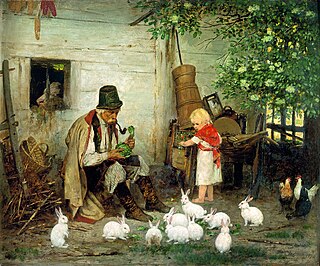
Cuniculture is the agricultural practice of breeding and raising domestic rabbits as livestock for their meat, fur, or wool. Cuniculture is also employed by rabbit fanciers and hobbyists in the development and betterment of rabbit breeds and the exhibition of those efforts. Scientists practice cuniculture in the use and management of rabbits as model organisms in research. Cuniculture has been practiced all over the world since at least the 5th century.

The Boer goat is a breed of goat that was developed in South Africa in the early 1900s and is a popular breed for meat production. Their name is derived from the Afrikaans (Dutch) word boer, meaning farmer.
The American Pygmy is an American breed of achondroplastic goat. It is small, compact and stockily built. Like the Nigerian Dwarf, it derives from the West African Dwarf group of breeds of West Africa. Between 1930 and 1960, animals of this type were imported to the United States for use either as zoo animals or for research; some were later kept and bred as companion animals and established as a breed in 1975. It may also be known as the Pygmy or African Pygmy. It is quite different and separate from the British Pygmy breed.

The Nigerian Dwarf is an American breed of dwarf goat. Like the American Pygmy Goat, it derives from the West African Dwarf group of breeds of West Africa.

A cashmere goat is a type of goat that produces cashmere wool, the goat's fine, soft, downy, winter undercoat, in commercial quality and quantity. This undercoat grows as the day length shortens and is associated with an outer coat of coarse hair, which is present all the year and is called guard hair. Most common goat breeds, including dairy goats, grow this two-coated fleece.
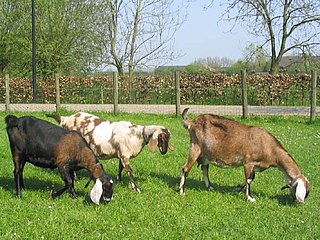
The Anglo-Nubian is a British breed of domestic goat. It originated in the nineteenth century from cross-breeding between native British goats and a mixed population of large lop-eared goats imported from India, the Middle East and North Africa. It is characterised by large, pendulous ears and a convex profile. It has been exported to many parts of the world, and is found in more than sixty countries. In many of them it is known simply as the Nubian.
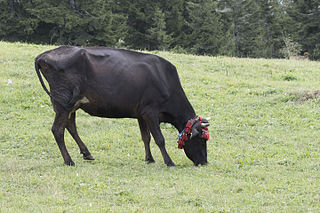
The Anatolian Black, also known as Native Black Cattle, is a breed of cattle that originated in Anatolia, in what is now Turkey. They are the most popular cattle breed in Turkey, and are used in dairy production, meat production, and as draught animals on small farms. They are primarily raised in central Turkey.

The Changthangi or Ladakh Pashmina is a breed of cashmere goat native to the high plateaux of Ladakh, India. The cold temperatures in the region are the primary factor in the growth of the fine pashmina grade of cashmere wool for which they are reared. It is also used as a pack animal and for meat.

Jamnapari or Jamunapari is an Indian breed of domestic goat originating in Uttar Pradesh. It has exported to Indonesia, where it is known as the Etawah. It is bred for both milk and meat. The name is derived from the Yamuna river.

The domestic goat or simply goat is a subspecies of C. aegagrus domesticated from the wild goat of Southwest Asia and Eastern Europe. The goat is a member of the animal family Bovidae and the subfamily Caprinae, meaning it is closely related to the sheep. There are over 300 distinct breeds of goat. It is one of the oldest domesticated species of animal, according to archaeological evidence that its earliest domestication occurred in Iran at 10,000 calibrated calendar years ago.
The Altai Mountain goat is a breed of domestic goat bred for wool production. The breed was developed during the years from 1944 to 1982 in the Gorno-Altai Autonomous Soviet Socialist Republic region of the Soviet Union, by cross-breeding the Don goat with local goats for a high wool yield.
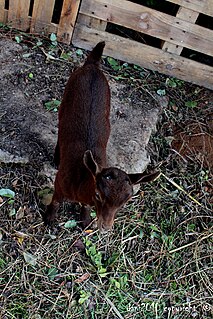
The Murciano-Granadina is a Spanish breed of dairy goat. It was created in 1975 when two existing breeds, the mahogany-coloured Murciana of Murcia and the black Granadina of Granada, began to be hybridised as a result of the official recognition of a single herdbook including both breeds. It is the most important dairy goat breed of Spain, with more than 500,000 milking females. It originated in the semi arid areas in south eastern Spain, including parts of Murcia, Almería, Granada and Alicante. They were bred for two main traits, milk production and its ability to continue this production in dry and nutrient poor regions. They have been introduced into several areas in Latin America as well as northern Africa.
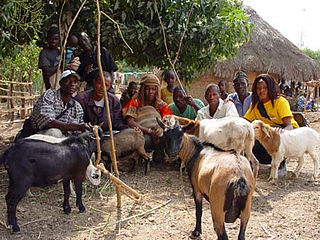
The West African Dwarf is a large and variable breed or group of breeds of domestic goat from coastal West and Central Africa, a range extending approximately from Senegal to Zaire. It is characterised by achondroplasia or dwarfism, a trait that may have evolved in response to conditions in the humid forests of the area, and also by some degree of resistance to tsetse-borne trypanosomiasis or "sleeping-sickness".
The Yanbian is a taurine breed of cattle that originated in northeast China. They belong to the "yellow" class of Chinese cattle, and are closely related to the Korean Hanwoo breed, having diverged from a common ancestor in the late 19th/early 20th century. Unlike the majority of Chinese cattle breeds, Yanbian have had no ancestral breeding with indicine cattle. They are mainly distributed in northeastern China, in the Jilin, Heilongjiang and Liaoning Provinces. In 2010, it was estimated there were 210,000 individuals.

The New Zealand is a breed of rabbit, which despite the name, is American in origin. The breed originated in California, possibly from rabbits imported from New Zealand. New Zealand rabbits are available in five colors recognized by the American Rabbit Breeders' Association (ARBA): white, red, black, blue, and broken. Crossbreeding can result in many other variations, such as gold tipped steel and chestnut agouti. They average 10–12 lb (4.5–5.4 kg) with the does being slightly larger than the bucks. New Zealands are bred for meat, pelts, show, and laboratory uses, being the most commonly used breed of rabbit both for testing and meat production. They are also bred as pet rabbits but mostly breed for meat.

The Black Bengal goat is a breed of goat found throughout Bangladesh, West Bengal, Bihar, Assam, and Odisha. This breed is usually colored black but it is also found in brown, white or gray. The Black Bengal goat is small in size but its body structure is tight. Its horns are small and legs are short. An adult male goat weights about 25 to 30 kg and female 20 to 25 kg. It is poor in milk production. It is very popular in Bangladesh because of its low demand for feed and high kid production rate. The Black Bengal goats gain sexual maturity at earlier age than most other breeds. The female goat becomes pregnant twice a year and gives birth to one to three kids. This breed can adapt to any environment easily and its disease resistance is very high.
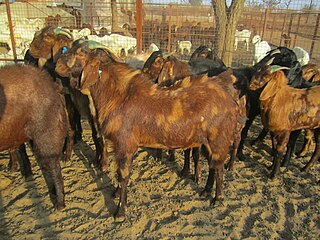
The Sirohi is an Indian breed of domestic goat. It is named for its area of origin, the Sirohi District of Rajasthan, in north-western India. It may be described as a dual-purpose breed, reared for both meat and milk production, or as meat breed. It is well adapted to the dry tropical climate of Rajasthan.
The Aspromonte or Capra dell'Aspromonte is an indigenous breed of domestic goat from the mountain massif of the Aspromonte, in the province of Reggio Calabria in Calabria in southern Italy, for which it is named. It is raised only in the province of Reggio Calabria, mainly in the Aspromonte, in the Altipiano dello Zomaro to the north-east, and in the Ionian coastal areas of the province, and particularly in areas of Grecanic culture. While the breed is thought to originate on the Aspromonte, it may have been influenced by the various other goat breeds, including the Abyssinian goat, the Maltese, and a type known as "Tibetan" with long silky hair, whose importation to Calabria in the early twentieth century is well documented.

Goat farming involves the raising and breeding of domestic goats as a branch of animal husbandry. People farm goats principally for their meat, milk, fibre and skins.
The Asmari is a large breed of goat originating in the Kunar province of Afghanistan. They are a general purpose breed, and are mainly used as pack animals and grown for their meat and milk. They are well adapted to local conditions, making them an important livestock resource for local farmers.
References
- 1 2 Zheng, Piliu (1985). "Livestock Breeds of China" (PDF). FAO Animal Production and Health Paper.
- 1 2 3 4 "Breeds of Livestock - Zhongwei Goats — Breeds of Livestock, Department of Animal Science". www.ansi.okstate.edu. Retrieved 2017-02-09.
- ↑ Du, Xiaoyong; Cao, Jianhua; Han, Xu; Hao, Huaizhi; Yu, Mei; Zhang, Guixiang; Zhao, Shuhong (2017). "Genetic diversity and population structure among eight Chinese indigenous goat breeds in the Yellow River valley". Small Ruminant Research. 148: 87–92. doi:10.1016/j.smallrumres.2016.12.034.
- ↑ Porter, Valerie; Alderson, Lawrence; Hall, Stephen J. G.; Sponenberg, D. Phillip (2016-03-09). Mason's World Encyclopedia of Livestock Breeds and Breeding, 2 Volume Pack. CABI. ISBN 9781845934668.
- ↑ Shang, Zhan-Huan. "Biodiversity in the Core Habitat of Zhongwei Goat in Ningxia". The Project of the National Natural Foundation of China– via Scienepaper Online.